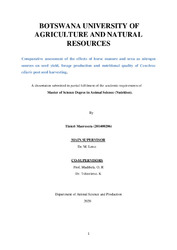| dc.description.abstract | The objective of this research was to evaluate the comparative effects of horse manure and urea, as sources of nitrogen, on seed and biomass yields of Cenchrus ciliaris and the nutritional quality of its forage residues after harvesting seeds. Two studies were carried out for the investigation. In the first study, 18 plots of C. ciliaris, grown from tussocks under irrigation, were used in a replicated 6 x 3 completely randomized design with 4 months experimental period. Six plots of C. ciliaris were assigned to each of the three treatments of no fertilizer, fertilizing with horse manure and fertilizing with urea. After four months, seed yield, forage dry matter yield, number of tillers per crown and lengths of inflorescences of the C. ciliaris were measured. Data were analyzed using the General Linear Model Procedures in Statistical Analysis System (SAS). Fertilizing C. ciliaris with either horse manure or urea caused a significantly (P < 0.05) higher seed yield, forage biomass yield and number of tillers per crown than the control treatment. There was no significant (P > 0.05) difference in the length of inflorescence of C. ciliaris between the two fertilizer treatments and the control. Fertilizing C. ciliaris with horse manure caused a significantly (P < 0.05) higher seed yield (18.46 ± 1.42 kg/ha) than fertilizing with urea (14.51 ± 1.92 kg/ha). There was no significant (P > 0.05) difference in number of tillers per crown between fertilizing with horse manure and fertilizing with urea. Fertilizing the C. ciliaris using urea caused a significantly (P < 0.05) higher forage biomass yield (2739.62 ± 274.42 kg dry matter/ha) than fertilizing with horse manure (2237.85 ± 118.99 kg dry matter/ha). This research, therefore, showed that fertilizing C. ciliaris with horse manure was superior to fertilizing it with urea in terms of increasing the seed yield but fertilizing it with urea was superior in terms of forage dry matter yield. If the objective is to produce seed, horse manure would be the source of nitrogen to use and if the target is to produce higher dry matter yields, urea would be preferable, all other factors held constant. In the second study, the C. sciliaris forage residues from the 18 plots in the first study were analyzed for nutritional quality after the seeds were harvested. It involved analyzing the residues for Crude Protein (CP), Acid Detergent Fiber (ADF), Neutral Detergent Fiber (NDF), Ash, minerals and In vitro Dry Matter digestibility (IVDMD). Fertilizing C. ciliaris with either horse manure or urea caused significantly (P < 0.05) higher CP and IVDMD than the control treatment. There was, however, no significant (P > 0.05) difference between fertilizing with horse manure and fertilizing with urea in terms of the two parameters. Fertilizing the grass with either horse manure or urea caused significantly (P < 0.05) lower ADF, NDF and ash contents than the control treatment. There was no significant (P > 0.05) 9 difference between fertilizing C. ciliaris with horse manure and fertilizing with urea in terms of these nutritional quality parameters. In terms of minerals, fertilizing with either horse manure or urea caused no significant (P > 0.05) difference from the control treatment, except in sulfur content where fertilizing with urea resulted in significantly (P < 0.05) higher levels (0.435% ± 0.018 dry matter) than the control treatment (0.230% ± 0.018 dry matter). It became evident from this study that there was no significant difference between fertilizing using horse manure and using urea in terms of increasing the nutritional quality of the forage residues of C. ciliaris. The two fertilizer treatments, however, increased the quality of the residues by increasing their CP content. Both fertilizer treatments also reduced the fibrosity of the forage residues and this could have contributed to increased digestibility of the forage residues. The results of this research show that C. ciliaris seed production can be done in the semi-arid areas of Botswana using horse manure and be used to establish a seed bank. Such a seed bank could then be used as source of forage propagation material to improve pastures. As further research, on-farm trials may need to be performed beyond the small plots experiment undertaken in this study in order to validate the adaptability and productivity of the grass under real field conditions across varied soils, moisture conditions and seasons. Keywords and phrases: nutritional quality, forage residues, forage dry matter yield, digestibility, forage biomass | en_US |

